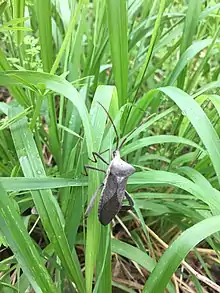| Acanthocephala declivis | |
|---|---|
 | |
| Scientific classification | |
| Domain: | Eukaryota |
| Kingdom: | Animalia |
| Phylum: | Arthropoda |
| Class: | Insecta |
| Order: | Hemiptera |
| Suborder: | Heteroptera |
| Family: | Coreidae |
| Genus: | Acanthocephala |
| Species: | A. declivis |
| Binomial name | |
| Acanthocephala declivis (Say, 1832) | |
Acanthocephala declivis, the giant leaf-footed bug, is a species of North American true bugs with a range from the southern United States to Guatemala and some Caribbean islands.[1] It is the largest of this genus within this range, generally growing to be 28 to 34 mm (1.1 to 1.3 in) long.[2] It can be distinguished from similar species by its much more broadly expanding pronotum, which extends much further than the abdomen, and the blunt tubercles on the midline of the anterior pronotal lobe, which is not present in other Acanthocephala species within its range.[3]
 dorsal view
dorsal view lateral view
lateral view
One specific characteristic about Acanthocephala declivis is that sexual competition by males pertaining to this species depend on their hind leg dimorphism. They use their legs to squeeze other males when competing for sexual partners. The length and diameter of the large tooth and femur of their hind legs are noticeably larger than the rest of their bodies, proportionally speaking. Females, on the other hand, don’t have these exceptionally large hind legs, although they also use them for mating aggression.4
References
- ↑ Blatchley, W. S. (1926). Heteroptera of Eastern North America. The Nature Publishing Company.
- ↑ Henry, Thomas J.; Froeschner, Richard C. (1988). Catalog of the Heteroptera, or True Bugs of Canada and the Continental United States. Brill Academic Publishers. ISBN 0-916846-44-X.
- ↑ "Identifying insects beyond Family". University of Florida. Archived from the original on 2010-03-04. Retrieved 2013-11-30.
External links
- Acanthocephala declivis at BugGuide.net